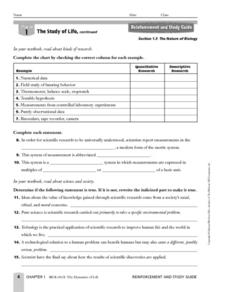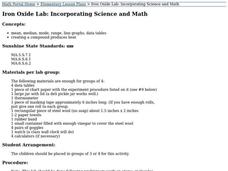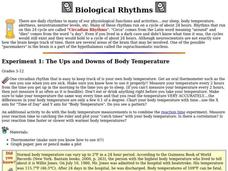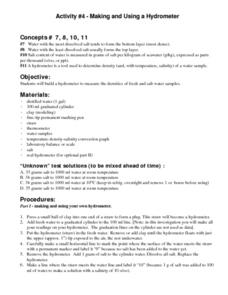Curated OER
Heat Misconceptions
Third graders determine that gloves do not provide heat, but rather, they insulate or hold in any heat that is in their hand. They discuss the different temperatures found in ecosystems around the world. What do animals that live in...
Curated OER
Greenhouse Gas Lab
Students compare the ability of a sample of carbon dioxide gas to
absorb thermal energy compared to a sample of air. They build a visual representation of the greenhouse effect to illustrate the heat-absorption of
atmospheric carbon...
Curated OER
Measuring Weight, Mass, and Capacity
Second graders measure weight, mass, and capacity. In this measurement lesson, 2nd graders model how to measure amounts of liquid by using containers that measure one cup, one pint, and one quart. Students compare the mass of each...
Curated OER
Quilts and the Underground Railroad
Third graders explore the use of freedom quilts in helping slaves escape to freedom using the Underground Railroad. They review the various quilt blocks that were used to give directions on the Underground Railroad. Students create their...
Curated OER
The Sky and the Dichotomous Key
Students use a dichotomous key to distinguish between different types of clouds
Curated OER
The Study of Life
In this scientific research worksheet, students will complete a chart by determining if the statements given are examples of quantitative research or descriptive research. Then students will fill in the blank of 8 statements about the...
Curated OER
Collect the Weather Lesson Plan
Students explore the weather. In this weather spreadsheet instructional activity, students keep track of weather patterns as they use instruments and resources to chart the data the collect in spreadsheet form.
Curated OER
Iron Oxide Lab: Incorporating Math and Science
Students conduct an experiment in small groups, draw conclusions about the amount heat of a compound achieves and practice their data analysis skills.
Curated OER
Biological Rhythms
Students conduct experiments to determine their circadian rhythms for a cycle of about 24 hours.
Curated OER
Weather Watchers
Young scholars practice using objective and quantitative means to describe and compare the weather. They compile weather conditions and create a spreadsheet to record their findings.
Curated OER
Farming: Seasons on a Wheat Farm (Lesson 4)
Young scholars explain the seasons on a wheat farm. They identify the uses of a grain elevator as well. They use a dry erase board to illustrate the seasons and the grain elevator in operation.
Curated OER
How Do I Measure Up? (Intermediate)
Fifth graders compare the relationship between meter in music and measurement in math. They practice sightreading music by determining the number of beats per measure, clapping and counting the rhythm.
Curated OER
Thunderstorms
Fourth graders investigate the attraction between two different charges to explain the concept of lightning in a thunderstorm.
Curated OER
The Ups and Downs of It: Wind
Students explore the ways in which wind is formed and how it affects our weather.
Curated OER
Dew Point
Fourth graders investigate saturation conditions and measure the dew point. They conduct an experiment, record data on a worksheet, and measure the dew point in the experiment.
Curated OER
Interdisciplinary Task: Weather
Students design a chart to use to record the weather for five days. They then build an anemometer to record wind speed and discover why they are used for this purpose.
Curated OER
Scale Matters
Third graders study the meaning of the digits an any whole numbers with up to 3 decimal places. They order decimals with up to 3 decimal places and perform measuring tasks, using a range of units and scales.
Curated OER
"Fall"owing Changes in the Season
Students create a whole class A-B-"C"eason Book. Each student is responsible for creating a "letter" page relating to changes, adaptations, or other fall concepts. After hard copies of the class ABC books are created, the teachers using...
Curated OER
Salinity in Mill Creek
Fifth graders use water samples collected at three different locations of Utah's Mill Creek to test salinity of water, hypothesize about salinity levels at each location, record results, and discuss their findings with classmates. ...
Curated OER
Making and Using a Hydrometer
Students build a hydrometer to measure the densities of fresh and salt water samples. They record the water temperature and density and use the temperature, density, and salinity conversion graph to locate the salinity. Finally,...
Curated OER
Anthropods and Echinoderms
Students examine the attributes of crickets. In this arthropods lesson, students observe crickets and sketch and label their parts. Students respond to questions regarding their observations.
Curated OER
Solar Water Heater Kit
For this earth science worksheet, students identify and experiment how hot water gets in a solar water heater. Then they respond to four short answer questions that follow related to the experiment.
Curated OER
Single Step Operations
In this math operations instructional activity, students solve the math story problems by solving single step operations. There are 10 problems on this instructional activity and the answers are on the second page.
Curated OER
Water Quality Survey
Students identify the differences in the water quality of a stream and complete water testing. In this water quality lesson students collect aquatic insects and identify them.
Other popular searches
- Thermometer Reading
- Reading Thermometers Math
- Reading Thermometer Celsius
- Reading Thermometer Scales
- Reading Thermometer Tiered
- Reading Thermometer Celcius

























